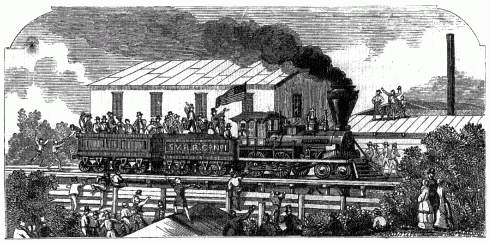Showing the ingenuity that helped build California, at a point approximately 20 miles from Sacramento a Mr. Anderson took the subcontract to grade and build the embankment for the new railroad. He had prospected the area before and knew that the dirt contained gold. Through the use of ingenious sluices and other methods, Mr. Anderson was able to recover enough gold to pay for the job and have his payment from the railroad as pure profit.
In spite of Mr. Anderson’s good fortune, as the work progressed financial problems soon arose with the Sacramento Valley Railroad. It had been a dry winter in California and, because of the reduction in mining, many of the financial institutions began to fail. New appeals for investors also failed and, on August 10, the Board of Directors of the Sacramento Valley Railroad met to discuss and remedy the situation.
The Board elected Commodore C. K. Garrison as its president. As Mayor of San Francisco, he had ruled the city with an iron hand and had proved to be a man of action. To the position of Vice-President came William Tecumseh Sherman (who would later leave California to become a General for the Union Army), now returned from the East and the head of the banking house of Lucas & Turner, one of the few institutions that had not failed, thanks to his careful management. The railroad needed strong leadership and a good banker, and it now had both.
On August 11, 1855, a day after the Board meeting, Judah and three others boarded a handcar on the rails, built to five-foot gauge, that were laid down Sacramento’s R Street and pushed their way down the tracks. It was not a long ride, only a mile or so, but it was a remarkable event for them.
A few days later, Judah stood on the levee watching while the small locomotive “Sacramento” was unloaded from the schooner “Two Brothers.” Just a few days later, on August 17, 1855, the little 4-4-0 locomotive was under a full head of steam, and construction engineer Lester Robinson and guests took a small excursion to Seventeenth Street, much to the applause and cheers of many who had gathered to watch.
Garrison and Sherman then invited several potential investors to come to Sacramento to view their now operating railroad and take the trip to the end of rail, followed by a carriage trip to Negro Bar.
The investors included tycoons J. Mora Moss, George F. Bragg, and the bankers Pioche and Bayreque, among others. Unfortunately they were not sufficiently impressed to further invest and, on October 18, 1855, because of lack of compensation to his firm, Lester Robinson attached the railroad through court action, placing it under a deed of trust, and appointing J. Mora Moss as the trustee. Fortunately, work continued under this arrangement.
By now the locomotive “Sacramento” had help on the rails. The engine “Nevada” had arrived from Boston and the locomotive “L. L. Robinson” from New Jersey. To add to these, Commodore Garrison had purchased the first railroad engine in California, the “Elephant”, which he renamed the “C. K. Garrison (it became the “Pioneer” 1868).
Passenger cars were being built by John Robinson (the Railroad’s Superintendent) at the foot of R Street, using wheels and iron work that had come from Boston. With all this rolling stock and the rails finally reaching the growing township of Folsom on January 1, 1856, it was time to celebrate a formal opening in a grand style.
On Washington’s Birthday, February 22, 1856, at 11 o’clock in the morning, the locomotive “Sacramento” pulled away from the Sacramento station with its string of passenger and flat cars carrying a large group of the local citizens and politicians. It was shortly followed by the “Nevada” which, in spite of developing mechanical problems, also arrived at the Meredith Hotel, in Folsom, in time for the celebration.
After speeches from Senator Flint and several of the Railroad’s Board Members, the guests were treated to a “Railroad Ball”, which we’re told lasted until 5:00 a.m. of the next day.
TO BE CONTINUED


1 comment for “Charles Lincoln Wilson – The Sacramento Valley Railroad, Part II”